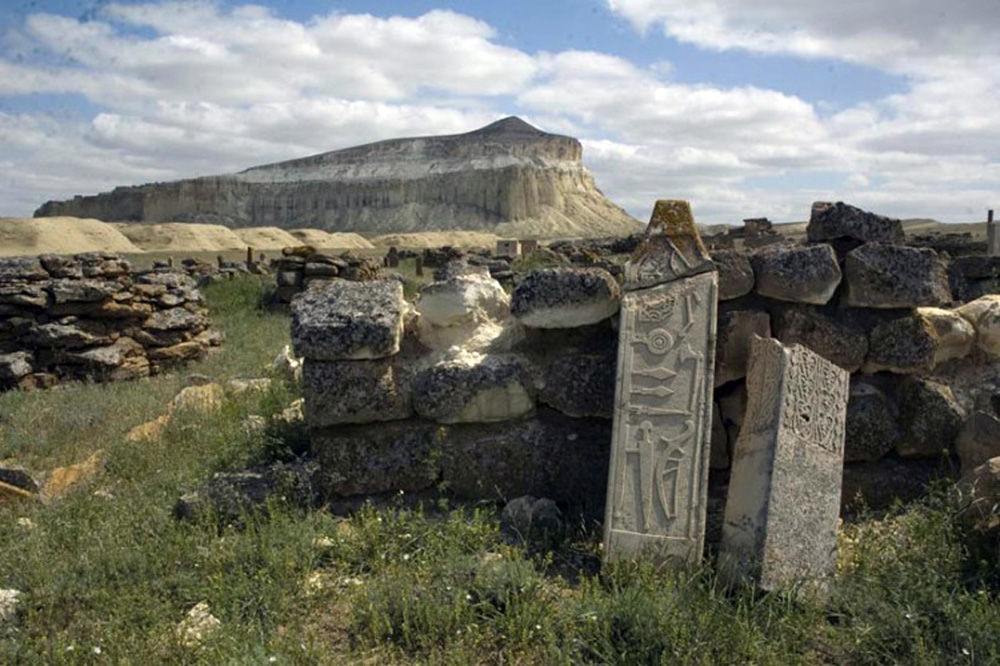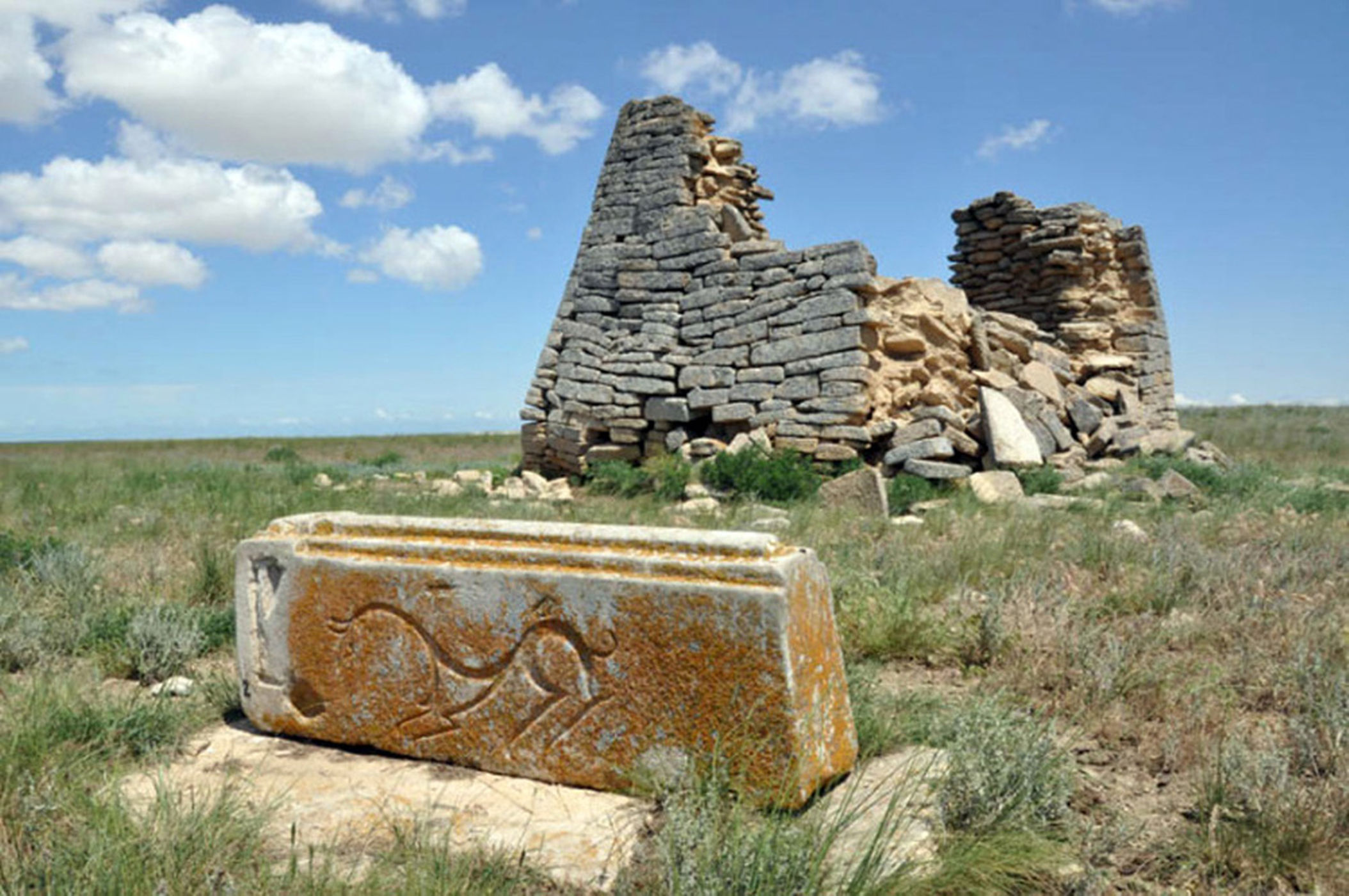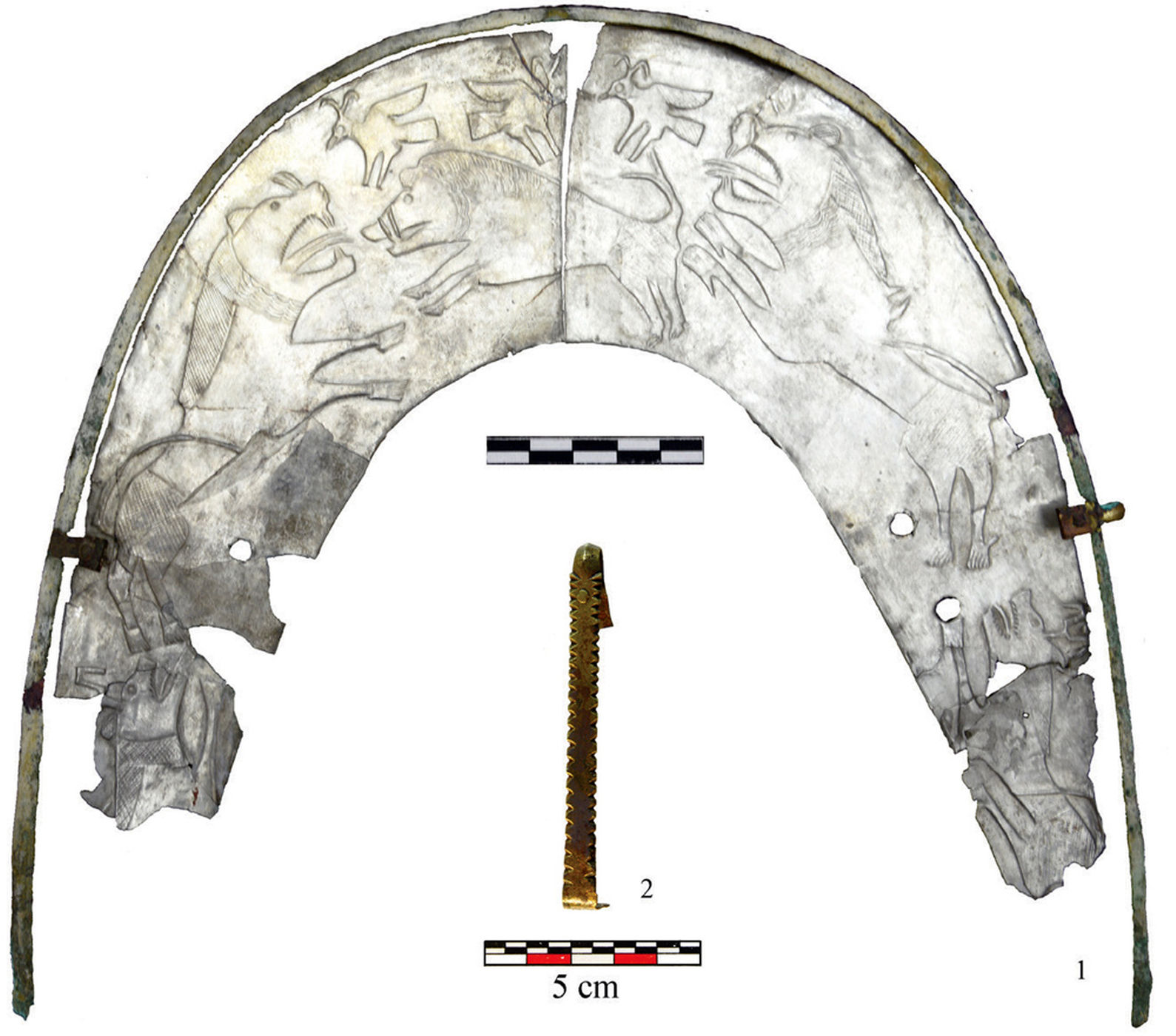It looks like you're using an Ad Blocker.
Please white-list or disable AboveTopSecret.com in your ad-blocking tool.
Thank you.
Some features of ATS will be disabled while you continue to use an ad-blocker.
25
share:
Back in 2010, a local man whose name is being given only as F. Akhmadulin, was metal detecting in a remote sagebrush semidesert area of Kazahkstan,
near the eastern shore of the Caspian Sea, when he hit upon pieces of silver saddle ornamentation near a large slab of stone.
The man, realizing that he'd found something of significance, brought the pieces to the Mangystau State Historical and Cultural Reserve where they were examined by archeaologist Andrey Astafiev. Akhmadulin later led Astafiev to the place where he'd found the silver artifacts which turned out to be the remains of a stone structure. Unfortunately, it was 2014 before archaeologists were able to obtain funding to begin excavations at the site which they soon discovered was much larger than they'd initially believed.
The team has recently published an article about the discovery entitled The Discovery of Altÿnkazgan in the journal, Ancient Civilizations from Scythia to Siberia.
Live Science - Built by the Huns? Ancient Stone Monuments Discovered Along Caspian
 (larger image)
(larger image)
There were a few more articles out but it's all the same stuff. Since I'm not shell out $30 to read the journal article today, I don't have a lot more detail at this point so you'll have to settle for a couple more pictures. I'd love to find the coordinates for this place to see what there is to be seen from satellite photos on Google Earth.


Lots of comparisons to Stone Henge but from the limited photos available, I'm far more reminded of something like Göbekli Tepe.
The man, realizing that he'd found something of significance, brought the pieces to the Mangystau State Historical and Cultural Reserve where they were examined by archeaologist Andrey Astafiev. Akhmadulin later led Astafiev to the place where he'd found the silver artifacts which turned out to be the remains of a stone structure. Unfortunately, it was 2014 before archaeologists were able to obtain funding to begin excavations at the site which they soon discovered was much larger than they'd initially believed.
The team has recently published an article about the discovery entitled The Discovery of Altÿnkazgan in the journal, Ancient Civilizations from Scythia to Siberia.
Live Science - Built by the Huns? Ancient Stone Monuments Discovered Along Caspian

A massive, 1,500-year-old stone complex that may have been built by nomad tribes has been discovered near the eastern shore of the Caspian Sea in Kazakhstan.
The complex contains numerous stone structures sprawled over about 300 acres (120 hectares) of land, or more than 200 American football fields, archaeologists reported recently in the journal Ancient Civilizations from Scythia to Siberia.
"When the area was examined in detail, several types of stone structures were identified," archaeologists Andrey Astafiev, of the Mangistaus State Historical and Cultural Reserve; and Evgeniï Bogdanov, of the Russian Academy of Sciences Siberian Department's Institute of Archaeology and Ethnography, wrote in the journal article. The smallest stone structures are only 13 feet by 13 feet (4 by 4 meters), and the biggest are 112 feet by 79 feet (34 by 24 m)
The design and decorations on the silver saddle indicate that it dates to a time when the Roman Empire was collapsing, and a group called the "Huns" were on the move across Asia and Europe, they said. "The advance of the Huns led various ethnic groups in the Eurasian steppes to move from their previous homelands," Astafiev and Bogdanov wrote.
The owner of the saddle was likely a person of considerable wealth and power as the archaeologists found symbols called "tamgas" engraved on the silver saddle above the heads of predators, something that can be "an indication of the privileged status of the saddle's owner." These signs may also be a link "to the clan to which the owner of the tamga belonged," Astafiev and Bogdanov wrote.
It's not exactly clear why the silver saddle was placed in the stone structure, though it may have been created for a ritual purpose or as a burial good, Astafiev and Bogdanov suggested. They found the remains of one skeleton buried beneath the stone structure; however, the skeleton may date to centuries after the silver saddle was deposited there.
There were a few more articles out but it's all the same stuff. Since I'm not shell out $30 to read the journal article today, I don't have a lot more detail at this point so you'll have to settle for a couple more pictures. I'd love to find the coordinates for this place to see what there is to be seen from satellite photos on Google Earth.


Lots of comparisons to Stone Henge but from the limited photos available, I'm far more reminded of something like Göbekli Tepe.
edit on
2016-11-16 by theantediluvian because: (no reason given)
An excellent find.
The way it's being instantly interpreted:
What nomadic tribe works in stone? Anyone have any idea how heavy stone artwork happens to be?
The way it's being instantly interpreted:
Leaves my head throbbing.
stone complex that may have been built by nomad tribes
What nomadic tribe works in stone? Anyone have any idea how heavy stone artwork happens to be?
a reply to: Snarl
I'm only speculating, but perhaps even nomads like to have a winter base. They could have conquered enough slaves to do the building work. The eastern coast of the Caspian is not far from the more settled areas of Persia, a little south of the main steppe, could have had a slightly better winter climate.
The artwork suits the nomadic world. I see wild boar in that bottom picture, a schematic horse in the one just above.
I'm only speculating, but perhaps even nomads like to have a winter base. They could have conquered enough slaves to do the building work. The eastern coast of the Caspian is not far from the more settled areas of Persia, a little south of the main steppe, could have had a slightly better winter climate.
The artwork suits the nomadic world. I see wild boar in that bottom picture, a schematic horse in the one just above.
edit on 16-11-2016 by DISRAELI because: (no reason given)
Excellent, why has it taken till now to "Find" this stuff, surely its been known for 100s of years??
Anyway, maybe they had a Sexy time in Kazaks.....
The Horse sculpture reminds me of the white horse bronze age chalk sculpture at Uffington in England.
Similar curvature design.
Another interesting piece of the puzzle, of Humans on Earth.
en.wikipedia.org...
Anyway, maybe they had a Sexy time in Kazaks.....
The Horse sculpture reminds me of the white horse bronze age chalk sculpture at Uffington in England.
Similar curvature design.
Another interesting piece of the puzzle, of Humans on Earth.
en.wikipedia.org...
edit on 16-11-2016 by gort51 because: forgot somvink
a reply to: Snarl
Wasn't the Jews from antiquity more or less travelling stone workers and masons? I am not saying that this site was their work but perhaps it was created by the ancient equivalent of traveling contractors of today? If the archeologists think it was made during a period of faltering Roman influence perhaps some of these people took off and started caravanning? Just a thought probably unfounded but your question made me think of that.
Wasn't the Jews from antiquity more or less travelling stone workers and masons? I am not saying that this site was their work but perhaps it was created by the ancient equivalent of traveling contractors of today? If the archeologists think it was made during a period of faltering Roman influence perhaps some of these people took off and started caravanning? Just a thought probably unfounded but your question made me think of that.
a reply to: Brotherman
Interesting that someone who builds stuff with their hands would post a reply to mine in this thread.
That stone with the horse carved on to it ... What do you make of the top? Those grooves?
Interesting that someone who builds stuff with their hands would post a reply to mine in this thread.
That stone with the horse carved on to it ... What do you make of the top? Those grooves?
a reply to: Snarl
To me I would imagine it was created by someone of skill and renown, consider if the sculptor/ artist wasn't the same person like the person who cut and shaped the stone wouldn't just let anyone carve a horse on it you'ld think. If it was the same person that did both the stone cutting and carving must've been a very talented person. I think the horse looks awesome and is laid out very nicely. I have no idea what the technique used to make the carving but it looks amazing with flowing curves and crisp straights, I dig it.
To me I would imagine it was created by someone of skill and renown, consider if the sculptor/ artist wasn't the same person like the person who cut and shaped the stone wouldn't just let anyone carve a horse on it you'ld think. If it was the same person that did both the stone cutting and carving must've been a very talented person. I think the horse looks awesome and is laid out very nicely. I have no idea what the technique used to make the carving but it looks amazing with flowing curves and crisp straights, I dig it.
Haven't read the article yet but, The main slab in the first picture looks like it could be used to make weapons. It seriously reminds me of mold and
cast weapons still on the sprue. Technically it could have been used to make weapons with a impression and an open face pour.
Awesome discovery
Awesome discovery
new topics
-
Advice for any young Adult .
General Chit Chat: 37 minutes ago -
Joe meant what he said about Hunter's pardon....
US Political Madness: 1 hours ago -
Regent Street in #London has been evacuated due to a “bomb threat.”
Other Current Events: 2 hours ago -
It’s Falling…
Philosophy and Metaphysics: 3 hours ago -
Steering the Titantic from the Drydock.
Rant: 6 hours ago
top topics
-
Steering the Titantic from the Drydock.
Rant: 6 hours ago, 10 flags -
Hearing more ambulances lately
Medical Issues & Conspiracies: 17 hours ago, 8 flags -
Los Angeles brush fires latest: 2 blazes threaten structures, prompt evacuations
Mainstream News: 17 hours ago, 7 flags -
Paramilitary Leaks - John Williams
Whistle Blowers and Leaked Documents: 15 hours ago, 7 flags -
Joe meant what he said about Hunter's pardon....
US Political Madness: 1 hours ago, 7 flags -
It’s Falling…
Philosophy and Metaphysics: 3 hours ago, 4 flags -
Advice for any young Adult .
General Chit Chat: 37 minutes ago, 4 flags -
Some sausage, some chicken, some sauce, some onions and some garlic...and some peppers!
Food and Cooking: 17 hours ago, 3 flags -
Regent Street in #London has been evacuated due to a “bomb threat.”
Other Current Events: 2 hours ago, 3 flags
active topics
-
Steering the Titantic from the Drydock.
Rant • 32 • : Boomer1947 -
Joe meant what he said about Hunter's pardon....
US Political Madness • 8 • : BeyondKnowledge3 -
Advice for any young Adult .
General Chit Chat • 3 • : AlroyFarms -
Regent Street in #London has been evacuated due to a “bomb threat.”
Other Current Events • 3 • : TimBurr -
Los Angeles brush fires latest: 2 blazes threaten structures, prompt evacuations
Mainstream News • 20 • : BeyondKnowledge3 -
Russia Ukraine Update Thread - part 3
World War Three • 6902 • : Oldcarpy2 -
It’s Falling…
Philosophy and Metaphysics • 2 • : JJproductions -
Hearing more ambulances lately
Medical Issues & Conspiracies • 4 • : JJproductions -
Meta Llama local AI system is scary good
Science & Technology • 51 • : imitator -
Judge rules president-elect Donald Trump must be sentenced in 'hush money' trial
US Political Madness • 65 • : network dude
25
